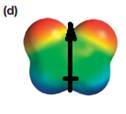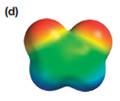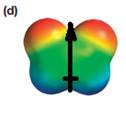
Concept explainers
(a)
Interpretation:
Given uncharged molecule is to be identified as polar or nonpolar, using its electrostatic potential map. If the molecule is polar, the direction of its net molecular dipole moment it to be determined.
Concept introduction:
A polar bond is one in which the bond pair is unequally shared by the two atoms.
A partial positive charge is developed on the less electronegative atom while and an equal but negative partial charge is developed on the more electronegative atom.
Molecules that contain more than one polar bond may or may not have a net dipole moment. The dipole moment is a vector quantity. The net molecular dipole moment is the result of the vector addition of all the individual dipole moments. Depending on the symmetry of the molecule, the individual bond dipoles can partly or completely cancel or reinforce each other.
A bond dipole or a molecular dipole is represented by an arrow pointing from the atom or region with a partial positive charge toward an atom or region with a partial negative charge.
Electrostatic potential maps of molecules show the distribution of electron density in different parts of the molecule. The electron density is represented by different colors, ranging from blue to red. Blue color indicates a low electron density, an atom or region with a partial positive charge. Red color indicates high electron density, an atom or region with a partial negative charge.
Answer to Problem 2.40P
The electrostatic potential map shows that the molecule is nonpolar.
Explanation of Solution

The electrostatic potential map shows the molecule with a negative charge concentrated at the center, with positive charge distributed symmetrically around the center. This shows that the individual bond dipoles are all of equal magnitude, and they all point toward the center. The vector addition of these dipoles will be zero because of their symmetric distribution. Therefore, the molecule is nonpolar.
The net dipole moment of a molecule is the vector sum of the individual bond dipoles.
(b)
Interpretation:
Given uncharged molecule is to be identified as polar or nonpolar, using its electrostatic potential map. If the molecule is polar, the direction of its net molecular dipole moment it to be determined.
Concept introduction:
A polar bond is one in which the bond pair is unequally shared by the two atoms.
A partial positive charge is developed on the less electronegative atom while and an equal but negative partial charge is developed on the more electronegative atom.
Molecules that contain more than one polar bond may or may not have a net dipole moment. The dipole moment is a vector quantity. The net molecular dipole moment is the result of the vector addition of all the individual dipole moments. Depending on the symmetry of the molecule, the individual bond dipoles can partly or completely cancel or reinforce each other.
A bond dipole or a molecular dipole is represented by an arrow pointing from the atom or region with a partial positive charge toward an atom or region with a partial negative charge.
Electrostatic potential maps of molecules show the distribution of electron density in different parts of the molecule. The electron density is represented by different colors, ranging from blue to red. Blue color indicates a low electron density, an atom or region with a partial positive charge. Red color indicates high electron density, an atom or region with a partial negative charge.
Answer to Problem 2.40P
The electrostatic potential map shows that the molecule is nonpolar.
Explanation of Solution

The electrostatic potential map shows a molecule with a negative charge concentrated at the center, with positive charge distributed symmetrically around the center. This shows that the individual bond dipoles are all of equal magnitude, and they all point toward the center. The vector addition of these dipoles will be zero because of their symmetric distribution. Therefore, the molecule is nonpolar.
The net dipole moment of a molecule is the vector sum of the individual bond dipoles.
(c)
Interpretation:
The given uncharged molecule is to be identified as polar or nonpolar, using its electrostatic potential map. If the molecule is polar, the direction of its net molecular dipole moment it to be determined.
Concept introduction:
A polar bond is one in which the bond pair is unequally shared by the two atoms.
A partial positive charge is developed on the less electronegative atom while and an equal but negative partial charge is developed on the more electronegative atom.
Molecules that contain more than one polar bond may or may not have a net dipole moment. The dipole moment is a vector quantity. The net molecular dipole moment is the result of the vector addition of all the individual dipole moments. Depending on the symmetry of the molecule, the individual bond dipoles can partly or completely cancel or reinforce each other.
A bond dipole or a molecular dipole is represented by an arrow pointing from the atom or region with a partial positive charge toward an atom or region with a partial negative charge.
Electrostatic potential maps of molecules show the distribution of electron density in different parts of the molecule. The electron density is represented by different colors, ranging from blue to red. Blue color indicates a low electron density, an atom or region with a partial positive charge. Red color indicates high electron density, an atom or region with a partial negative charge.
Answer to Problem 2.40P
The electrostatic potential map shows that the molecule is polar.
The direction of the net molecular dipole is downward as shown below.

Explanation of Solution

The electrostatic potential map shows a molecule with an asymmetric charge distribution. The positive charge is concentrated on the atom at the top, while the negative charge is distributed on three atoms at the bottom. The individual bond dipoles will therefore not cancel completely. Therefore, the molecule is polar.
The direction of the molecular dipole will be downward, as shown below by the black arrow.

The net dipole moment of a molecule is the vector sum of the individual bond dipoles.
(d)
Interpretation:
The given uncharged molecule is to be identified as polar or nonpolar, using its electrostatic potential map. If the molecule is polar, the direction of its net molecular dipole moment it to be determined.
Concept introduction:
A polar bond is one in which the bond pair is unequally shared by the two atoms.
A partial positive charge is developed on the less electronegative atom while and an equal but negative partial charge is developed on the more electronegative atom.
Molecules that contain more than one polar bond may or may not have a net dipole moment. The dipole moment is a vector quantity. The net molecular dipole moment is the result of the vector addition of all the individual dipole moments. Depending on the symmetry of the molecule, the individual bond dipoles can partly or completely cancel or reinforce each other.
A bond dipole or a molecular dipole is represented by an arrow pointing from the atom or region with a partial positive charge toward an atom or region with a partial negative charge.
Electrostatic potential maps of molecules show the distribution of electron density in different parts of the molecule. The electron density is represented by different colors, ranging from blue to red. Blue color indicates a low electron density, an atom or region with a partial positive charge. Red color indicates high electron density, an atom or region with a partial negative charge.
Answer to Problem 2.40P
The electrostatic potential map shows that the molecule is polar.
The direction of the net molecular dipole is upward, as shown below.

Explanation of Solution

The electrostatic potential map shows a molecule with a negative charge distributed on two atoms at the top and the positive charge distributed on two atoms at the bottom. This shows that the individual bond dipoles both point approximately upward and slightly away from the center line. The vector addition of these dipoles will be nonzero. Therefore, the molecule is polar.
The direction of the net dipole moment will be upward as shown below.

The net dipole moment of a molecule is the vector sum of the individual bond dipoles.
(e)
Interpretation:
The given uncharged molecule is to be identified as polar or nonpolar, using its electrostatic potential map. If the molecule is polar, the direction of its net molecular dipole moment it to be determined.
Concept introduction:
A polar bond is one in which the bond pair is unequally shared by the two atoms.
A partial positive charge is developed on the less electronegative atom while and an equal but negative partial charge is developed on the more electronegative atom.
Molecules that contain more than one polar bond may or may not have a net dipole moment. The dipole moment is a vector quantity. The net molecular dipole moment is the result of the vector addition of all the individual dipole moments. Depending on the symmetry of the molecule, the individual bond dipoles can partly or completely cancel or reinforce each other.
A bond dipole or a molecular dipole is represented by an arrow pointing from the atom or region with a partial positive charge toward an atom or region with a partial negative charge.
Electrostatic potential maps of molecules show the distribution of electron density in different parts of the molecule. The electron density is represented by different colors, ranging from blue to red. Blue color indicates a low electron density, an atom or region with a partial positive charge. Red color indicates high electron density, an atom or region with a partial negative charge.
Answer to Problem 2.40P
The electrostatic potential map shows that the molecule is polar.
The direction of the net molecular dipole is upward as shown below.

Explanation of Solution

The electrostatic potential map shows a molecule with a negative charge concentrated on the atom at the top center, with positive charge distributed over atoms on the side and at the bottom. This shows that the individual bond dipoles are not symmetrically distributed and will not cancel out completely. Therefore, the molecule is polar.
The direction of the net molecular dipole will be upward because of the concentration of negative charge at the top and a symmetrical distribution of the positive charge in the rest of the molecule.

The net dipole moment of a molecule is the vector sum of the individual bond dipoles.
(f)
Interpretation:
The given uncharged molecule is to be identified as polar or nonpolar, using its electrostatic potential map. If the molecule is polar, the direction of its net molecular dipole moment it to be determined.
Concept introduction:
A polar bond is one in which the bond pair is unequally shared by the two atoms.
A partial positive charge is developed on the less electronegative atom while and an equal but negative partial charge is developed on the more electronegative atom.
Molecules that contain more than one polar bond may or may not have a net dipole moment. The dipole moment is a vector quantity. The net molecular dipole moment is the result of the vector addition of all the individual dipole moments. Depending on the symmetry of the molecule, the individual bond dipoles can partly or completely cancel or reinforce each other.
A bond dipole or a molecular dipole is represented by an arrow pointing from the atom or region with a partial positive charge toward an atom or region with a partial negative charge.
Electrostatic potential maps of molecules show the distribution of electron density in different parts of the molecule. The electron density is represented by different colors, ranging from blue to red. Blue color indicates a low electron density, an atom or region with a partial positive charge. Red color indicates high electron density, an atom or region with a partial negative charge.
Answer to Problem 2.40P
The electrostatic potential map shows that the molecule is nonpolar.
Explanation of Solution

The electrostatic potential map shows a charge distribution that is symmetric about the center of the molecule with two negative regions opposite each other across the center as well as two positive regions across the center. The individual bond dipoles will therefore cancel out completely. Therefore, the net dipole moment will be zero, and the molecule will be nonpolar.
The net dipole moment of a molecule is the vector sum of the individual bond dipoles.
Want to see more full solutions like this?
Chapter 2 Solutions
ORGANIC CHEMISTRY PRINCIPLES & MECHANISM
- draw the enolate anion and the carbonyl that would be needed to make this product through an aldol addition reaction.arrow_forwardDraw the Michael Adduct and the final product of the Robinson annulation reaction. Ignore inorganic byproducts.arrow_forwardDraw the Michael adduct and final product of the Robinson annulation reaction. Ignore inorganic byproductsarrow_forward
- Post Lab Questions. 1) Draw the mechanism of your Diels-Alder cycloaddition. 2) Only one isomer of product is formed in the Diels-Alder cycloaddition. Why? 3) Imagine that you used isoprene as diene - in that case you don't have to worry about assigning endo vs exo. Draw the "endo" and "exo" products of the Diels-Alder reaction between isoprene and maleic anhydride, and explain why the distinction is irrelevant here. 4) This does not hold for other dienes. Draw the exo and endo products of the reaction of cyclohexadiene with maleic anhydride. Make sure you label your answers properly as endo or exo. 100 °C Xylenes ??? 5) Calculate the process mass intensity for your specific reaction (make sure to use your actual amounts of reagent).arrow_forwardIndicate the product(s) A, B C and D that are formed in the reaction: H + NH-NH-CH [A+B] [C+D] hydrazonesarrow_forwardHow can you prepare a 6 mL solution of 6% H2O2, if we have a bottle of 30% H2O2?arrow_forward
- How many mL of H2O2 from the 30% bottle must be collected to prepare 6 mL of 6% H2O2.arrow_forwardIndicate the product(s) B and C that are formed in the reaction: HN' OCH HC1 B + mayoritario C minoritario OCH3arrow_forwardIndicate the product(s) that are formed in the reaction: NH-NH, OCH3 -H₂O OCH3arrow_forward
- 21.38 Arrange the molecules in each set in order of increasing acidity (from least acidic to most acidic). OH OH SH NH2 8 NH3 OH (b) OH OH OH (c) & & & CH3 NO2 21.39 Explain the trends in the acidity of phenol and the monofluoro derivatives of phenol. OH OH OH OH PK 10.0 PK 8.81 PK 9.28 PK 9.81arrow_forwardidentify which spectrum is for acetaminophen and which is for phenacetinarrow_forwardThe Concept of Aromaticity 21.15 State the number of 2p orbital electrons in each molecule or ion. (a) (b) (e) (f) (c) (d) (h) (i) DA (k) 21.16 Which of the molecules and ions given in Problem 21.15 are aromatic according to the Hückel criteria? Which, if planar, would be antiaromatic? 21.17 Which of the following structures are considered aromatic according to the Hückel criteria? ---0-0 (a) (b) (c) (d) (e) (h) H -H .8.0- 21.18 Which of the molecules and ions from Problem 21.17 have electrons donated by a heteroatom?arrow_forward
 Organic Chemistry: A Guided InquiryChemistryISBN:9780618974122Author:Andrei StraumanisPublisher:Cengage Learning
Organic Chemistry: A Guided InquiryChemistryISBN:9780618974122Author:Andrei StraumanisPublisher:Cengage Learning
